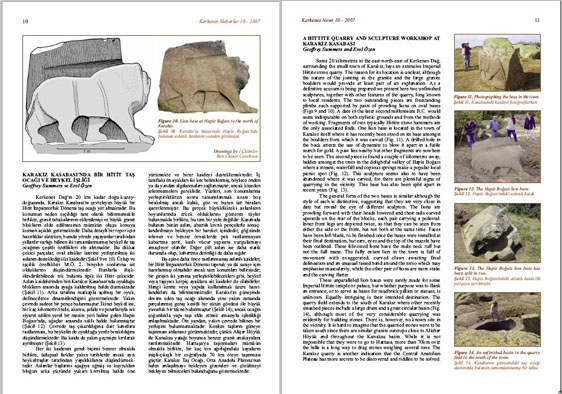| |
A HITTITE QUARRY AND SCULPTURE WORKSHOP AT KARAKIZ KASABASI Geoffrey Summers and Erol Özen
Some 20 kilometres to the east-north-east of Kerkenes Dað, surrounding the small town of Karakýz, lays an extensive Imperial Hittite stone quarry. The reason for its location is unclear, although the nature of the jointing in the granite and the large granite boulders would provide at least part of an explanation. As a definitive account is being prepared we present here two unfinished sculptures, together with other features of the quarry, long known to local residents. The two outstanding pieces are freestanding plinths each supported by pairs of prowling lions on oval bases (Figs 9 and 10). A date in the later second millennium B.C. would seem indisputable on both stylistic grounds and from the methods of working. Fragments of two typically Hittite stone hammers are the only associated finds. One lion base is located in the town of Karakýz itself where it has recently been stood on its base amongst the boulders from which it was carved (Fig. 11). A drilled hole in the back attests the use of dynamite to blow it apart in a futile search for gold. A paw lies nearby but other fragments are nowhere to be seen. The second piece is found a couple of kilometres away, hidden amongst the trees in the delightful valley of Hapis Boðazý where a stream, waterfall and copious springs make a popular local picnic spot (Fig. 12). This sculpture seems also to have been abandoned where it was carved, for there are plentiful signs of quarrying in the vicinity. This base has also been split apart in recent years (Fig. 13). The general form of the two bases is similar although the style of each is distinctive, suggesting that they are very close in date but reveal the eye of different sculptors. The lions are prowling forward with their heads lowered and their tails curved upwards on the rear of the blocks, each pair carrying a pedestal. Inner front legs are depicted twice, so that they can be seen from either the side or the front, but not both at the same time. Faces have been left blank, to be finished once the bases were installed at their final destination, but ears, eyes and the top of the muzzle have been outlined. These life-sized lions have the male neck ruff but not the full mane. The fully extant lion in the town is full of movement with exaggerated, curved claws awaiting final delineation and an unusual raised band around the torso which may emphasise muscularity, while the other pair of lions are more static and the carving flatter. These unparalleled lion bases were surely made for some Imperial Hittite temple or palace, but whether purpose was to flank an entrance, or to serve as bases for mudbrick pillars or statues, is unknown. Equally intriguing is their intended destination. The quarry field extends to the south of Karakýz where other recently smashed pieces include a large drum and a great circular basin (Fig. 14), although most of the very considerable quarrying was evidently for building stones. There is, however, no known site in the vicinity. It is hard to imagine that the quarried stones were to be taken south since there are similar granite outcrops close to Alishar Höyük and throughout the Kanaksu basin. While it is not impossible that they were to go to Hattusa, more than 70km over the hills is a long way to drag stones weighing several tons. The Karakýz quarry is another indication that the Central Anatolian Plateau has more secrets to be discovered and riddles to be solved. |



